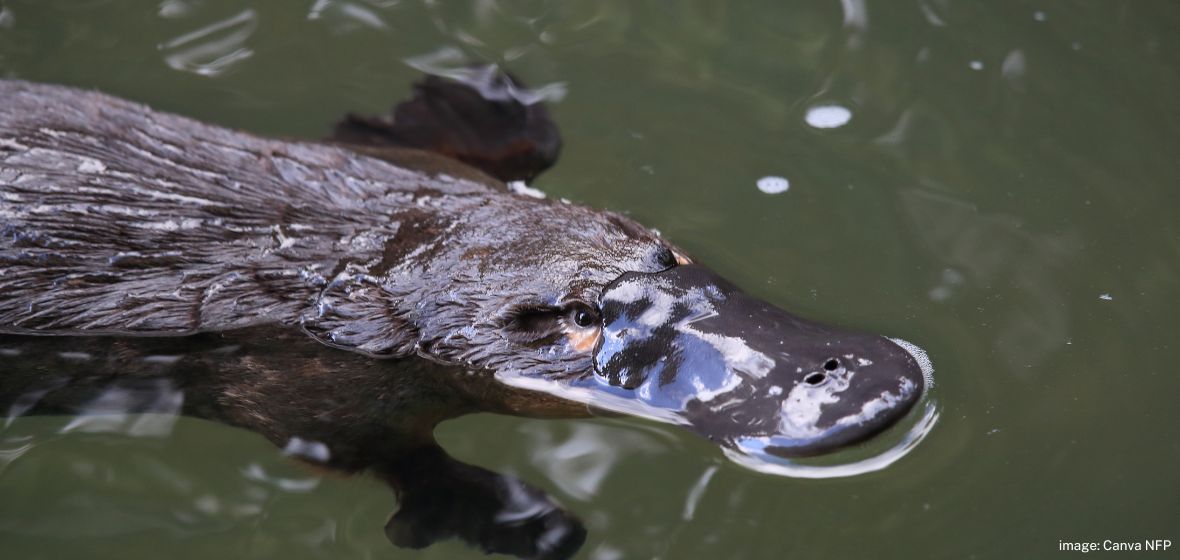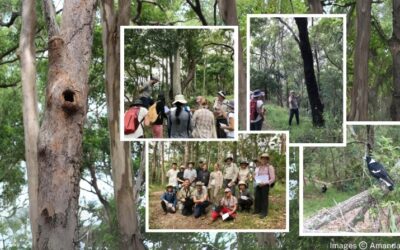
2 May 2024 | By Amanda Little
Australia’s iconic platypus inhabits creeks and rivers from Tasmania up the east coast to Cooktown in Queensland. Despite their distinctive appearance with a duck-like bill, webbed feet and thick tail, spotting a platypus in the wild can be quite challenging due to their elusive nature. Increase your platypus-spotting success with these top tips.
The platypus, a unique monotreme, differs from other mammals in that it lays eggs and secretes milk from pores on the mother’s belly instead of teats. These nocturnal, carnivorous creatures can spend over 12 hours per day foraging, consuming 13% to 28% of their body weight—a rate that increases for breeding females.
One of the platypus’s most fascinating adaptations is its bill, equipped with electroreceptors. These receptors detect the electrical signals emitted by prey such as aquatic insect larvae and crustaceans amid creek debris.
Spotting a platypus in the wild is a truly mesmerizing experience, and knowing what signs to look for greatly increases your chances.
What to look for
- Look for signs in the water: Watch for concentric circles or ripples when they dive, and trails of bubbles may also indicate their movement underwater. Also, watch for a clear bow-wave created by platypuses swimming at the surface. This is especially visible when they are actively feeding or moving between areas.
- Observe the shoreline: Search for slide marks and burrow entrances on the banks, usually 10-15 cm in diameter, often concealed by overhangs or vegetation.
- Identify footprints: Platypuses can leave unique footprints in the soft mud near the banks of their habitat. Look for these near the entrances of their burrows, which are typically dug into sturdy riverbanks.
- Expect smaller sizes: Male platypuses average 50 cm in length and weigh about 1.5 kg, while females are smaller, around 40 cm and 1 kg. Observers are often surprised by their smaller-than-expected size, especially on the mainland.
- Understand their habitat: Platypuses thrive in clean rivers and creeks with medium-flowing currents that feature sturdy banks, submerged logs, and overhangs.
- Timing is key: Platypuses are most active during dawn and dusk, often with increased visibility during the breeding season in late winter months when males are particularly active.

Circular pattern of ripples surrounding a platypus.

The entrance to a platypus burrow.
Is it a platypus or a rakali?
Despite the platypus’s unique features, it can still be mistaken for other species such as aquatic birds or rakali (native water rats) under poor lighting or from a distance.
Both rakali and platypuses are furry, semi-aquatic mammals that share similar sizes and colours, and often inhabit the same waterways. While platypuses are known for their unique electroreception abilities to navigate and hunt underwater, their coexistence in similar habitats can make them difficult to distinguish.
Watch our video to learn more about their differences and discover fascinating facts that will help you accurately identify a platypus in the wild.
Understanding and protecting platypuses
Wildlife Queensland’s PlatypusWatch has been monitoring platypuses for over eight years, using environmental DNA (eDNA) to track their presence in the Greater Brisbane area. This research supports local conservation efforts such as enhancing riverbank vegetation to protect their natural habitats from erosion and pollution.
In addition, since 2009, Wildlife Queensland has campaigned for a ban on enclosed opera house-style nets in Queensland. Queensland remains the only state not to have fully ban these nets, which continue to cause the indiscriminate drowning deaths of platypuses and other native aquatic wildlife.
These iconic, one-of-a-kind Australian monotremes need all the help they can get. Alarmingly, some of our eDNA studies in Brisbane waterways have shown negative results for platypus DNA in habitats where platypuses have traditionally been seen. By understanding where platypuses are vulnerable, we can better management decisions to protect this elusive species.
How you can help
- Maintain native vegetation along waterways.
- Dispose of rubbish properly and avoid using harmful chemicals near water systems.
- Conserve water to reduce the need for excessive irrigation.
- Sign our petition to ban opera house nets (enclosed yabby traps) in Queensland
- Report platypus sightings in Queensland to PlatypusWatch: Your sighting information helps us monitor their population and distribution and identify where actions are needed to protect them.
More Wildlife Blogs
5 fascinating facts about Australia’s iconic eucalypts
Eucalypts, those quintessentially Aussie trees, are a true-blue symbol of our land. With approximately 900 species of eucalypt on the planet, almost all of which are native to Australia, it’s no wonder they have their own national day on 23 March!
Who’s visiting your backyard? Identifying wildlife from their scat
Whether you’re in your backyard, exploring a park, or hiking through the bush, do you ever wonder what wildlife species are nearby? Even when wildlife isn’t readily visible, they often leave subtle traces of their presence. One such clue that nature leaves behind is scat, the faeces of animals.
Connecting people and planet on World Wildlife Day
On Sunday 3 March 2024, join us in celebrating Queensland’s incredible biodiversity and taking action to protect it. From wildlife conservation events to community clean-up efforts, there are plenty of opportunities to get involved and make a difference.



